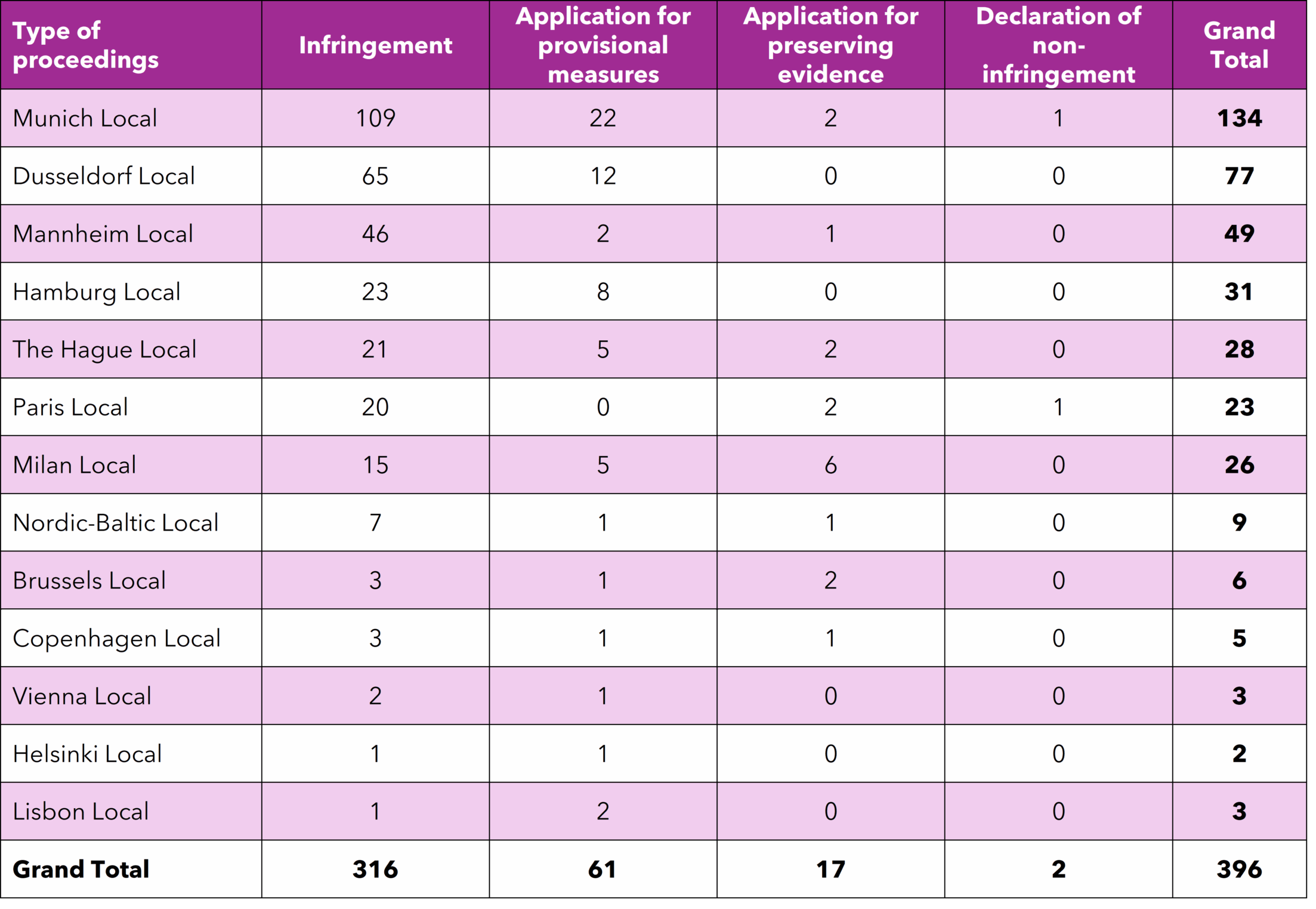
Two years on, the Unified Patent Court (UPC) has settled into its role as Europe’s single forum for cross-border patent enforcement. What began as an experimental pilot has become a proving ground, actively shaping litigation strategies across the region. Designed to simplify disputes involving European and Unitary Patents in participating European Union (EU) states, the UPC’s early years have already revealed clear behavioral trends: where cases are filed, how parties are pursuing preliminary measures, and which divisions are emerging as strategic hubs.
Using Darts-ip patent litigation data, we’ve taken a close look at what year two reveals about filing momentum, forum dynamics and early litigation behavior. Insights explored in depth below include a steady rise in filings, Germany’s continued dominance and The Hague’s emergence as a critical venue to watch.
Year 1 language and representation patterns as context
Looking back at the UPC’s inaugural year provides useful context for understanding year two trends. English was the most common language, used in nearly half of all cases (49.8%), followed closely by German at 43.5%, reflecting the court’s multilingual nature and appeal to both domestic and international parties.
Litigation was also highly concentrated among a small group of law firms. The top 10 firms handled over 70% of cases, with the top five responsible for half of all filings. This concentration highlights that a limited number of experienced representatives were shaping the court’s early procedural and substantive trends – a dynamic that will likely continue to influence strategic decisions as the UPC matures.
Filing growth: From steady start to acceleration for infringement actions
As Figures 1a and 1b illustrate, the UPC’s second year of filing data shows a system that’s gaining traction, even if growth isn’t linear. Infringement actions at the UPC increased by roughly 31.8% in year two, averaging close to 15 filings per month compared with around 12 in year one. While monthly activity still fluctuates, the overall pattern is one of growing consistency and confidence among users. Overall activity, including counterclaims and applications, grew in parallel. Counterclaims for revocation accompanied about half of infringement actions (65 in 138 infringement proceedings) (47.1%) in the first year but increased to 59.3% in year two (108 in 182 infringement proceedings). These relatively low percentages likely reflect the practical challenges defendants face in mounting a defense under the UPC’s accelerated timelines. Actions must be initiated within two months of service, and with cases typically concluding in about a year, the compressed schedule leaves little room for developing complex counterclaims.

Figure 1a: Number of actions filed during UPC’s first year

Figure 1b: Number of actions filed during UPC’s second year
Local and regional division activity: Germany’s continued dominance
Figures 2a and 2b compare proceedings per division between years one and two, demonstrating that the German Local Divisions remain the cornerstone of UPC litigation. Collectively, they account for 76.8% of all actions and infringement cases across Local and Regional Divisions, with Munich consistently leading. In year one, Munich handled almost 38% of all infringement cases, followed by Düsseldorf and Mannheim, and maintained its lead across counterclaims and preliminary proceedings.
By year two, Munich still leads, but its share dipped slightly to 34.5%, reflecting a modest diversification of filings across other divisions. Düsseldorf and Mannheim continue to rank high, and Hamburg has also seen rising activity. This sustained concentration highlights both the experience and efficiency of German divisions as key drivers for strategic forum selection. It also underscores that forum shopping within the UPC remains possible, with plaintiffs able to select divisions based on the location of the defendant, the infringement, or mutual agreement.
These trends suggest that for in-house counsel and litigation partners, Germany remains the primary battleground under the UPC, offering predictability — a critical factor in planning enforcement strategies.

Figure 2a: Number of proceedings per local / regional divisions during UPC’s first year

Figure 2b: Number of proceedings per local / regional divisions after 2 years
The Hague’s rise: The non-German outlier to watch
While German Local Divisions dominate, the second year of UPC operations shows a notable shift: The Hague has overtaken Paris as the top non-German forum. After two years, it ranks 5th among Local Divisions for both overall actions and infringement filings, handling 21 infringement cases and 28 total actions.
This rise reflects The Hague’s growing credibility as a venue for international parties seeking a non-German forum. Factors likely include familiarity with English-language proceedings and efficient handling of complex cross-border disputes. While German divisions still account for roughly 77% of infringement filings, The Hague’s appearance in the top five signals that forum choice is increasingly strategic, not merely procedural.
The Hague is the non-German division to watch. Parties weighing UPC litigation now have a credible alternative to German courts, making forum selection a key lever in planning timing, language and panel composition.
From experiment to enforcement strategy
Translating this litigation data into real-world IP strategy implications, we see that the UPC is clearly no longer an experimental venue but rather has become a strategic forum that can shape cross-border enforcement outcomes across Europe. The data shows that filing volumes are rising, German divisions continue to dominate and The Hague emerging as a credible non-German alternative.
Another notable trend is the way the UPC is being used alongside existing litigation. In its first year, many claimants turned to the court as an additional front in ongoing disputes — a way to apply pressure and accelerate settlement. By year two, that dynamic has evolved: among the patents involved in infringement proceedings before the UPC, significantly fewer were asserted in a previous parallel infringement case outside the UPC. This suggests the court is no longer just a secondary battlefield but increasingly a starting point for enforcement strategies.
For in-house counsel and litigation partners, this means forum choice, timing and case strategy now carry real consequences.
Selecting the right division can influence the success rates, such as infringement win rate, preliminary injunction grant rate, language, judicial expertise in the concerned technical domain and procedural timelines the Similarly, deciding when to file, whether to wait for initial case law or act quickly to secure a strategic advantage, can materially affect enforcement outcomes.
In short, the UPC has moved from pilot to proven arena, and stakeholders who incorporate data-driven insights into forum selection and timing decisions are likely to gain a competitive edge in European patent litigation.
About the data
Scope: June 1, 2023 – May 31, 2025
- Source: Darts-ip patent litigation database
- Coverage: All UPC actions, including main proceedings and preliminary measures, counted as separate proceedings
- Counting rules: Monthly counts reflect the number of distinct actions filed per division, providing a consistent view of filing patterns across time and forums
Related resources
A look back: Compare to the UPC’s inaugural year patterns.





